The Electronic Intifada 5 March 2014
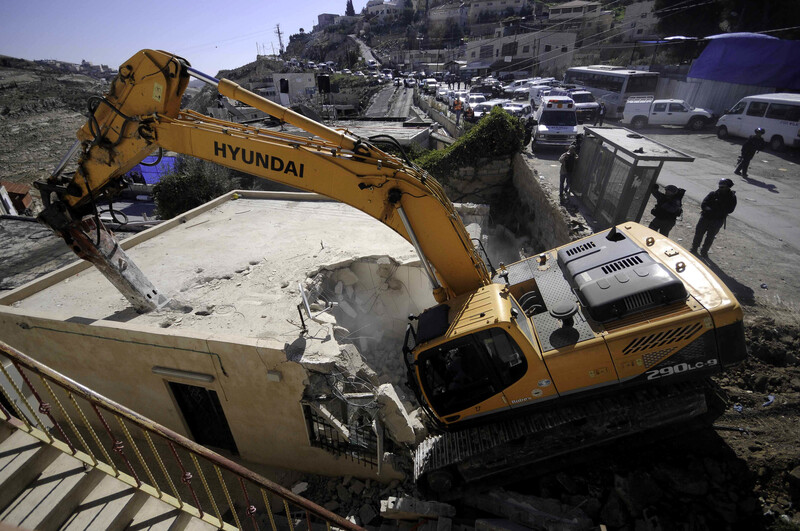
Israeli municipality workers demolish a house belonging to a Palestinian family that the authorities say was built without permission in the Jabal al-Mukabbar neighborhood in southern Jerusalem, 5 February.
APA imagesDuring the month of February, ongoing fighting in the area of Yarmouk camp south of Damascus interrupted aid distribution to the approximately 20,000 remaining Palestinian refugees residing there.
Various sides in the Syrian conflict had previously reached an agreement to allow aid workers to deliver supplies after several consecutive months of siege during which dozens of residents died of starvation.
Five Palestinian refugee school children in the ninth grade and a nurse on the staff of UNRWA, the UN agency for Palestine refugees, were among the at least 18 killed when an explosive struck near an UNRWA school in Muazeirib near Deraa in southern Syria.
On 18 February at least twenty others were injured, including eight children, two of whom have lost limbs, according to a statement by UNRWA’s commissioner-general. The deadly strike came “just eight days after UNRWA condemned an explosion that injured 40 school children at UNRWA’s Turaan School in the same town,” the agency added.
Meanwhile in the occupied West Bank, Israeli forces lay siege to a home in Birzeit village north of Ramallah during a raid. Muataz Washaha, 24, was killed when Israeli forces demolished part of the home and opened fire on the building after the activist affiliated with the Popular Front for the Liberation of Palestine reportedly refused to surrender.
Clashes between the Israeli army and Palestinians near Ramallah’s al-Jalazone refugee camp continued after Israeli forces killed a young laborer from the camp late last month, the UN agency OCHA reported.
Four Palestinian men were bitten by dogs used by Israeli forces at Hamra checkpoint in the northern West Bank; Israeli settlers severely beat and injured a 40-year-old Palestinian man from al-Lubban al-Sharqiya village near Nablus on 11 February, OCHA added.
In the occupied Gaza Strip, a 31-year-old man was killed by Israeli forces while reportedly collecting gravel and scrap metal near the boundary with Israel and the Israeli air force attempted to extrajudicially execute an alleged member of an armed group while he was traveling on a motorcycle in Deir al-Balah.
The targeted man was injured along with two bystanders, according to OCHA.
On 21 February, Israeli forces shot and injured twelve civilians, including two children, during a protest against Israeli restrictions on Palestinian access to land near Gaza’s boundary with Israel.
According to OCHA, “This type of incident has been on the rise since the beginning of the year, resulting in the injury of forty civilians …” That same day, two other Palestinians, including a 12-year-old herder, were shot and injured near the boundary with Israel in the south of the Gaza Strip, according to OCHA.
Rafah crossing was open for only eight days from the beginning of the month through 24 February. Prior to restrictions imposed by the Egyptian government following the ouster of President Muhammad Morsi, Rafah crossing functioned as the sole exit and entry for the vast majority of Palestinians in Gaza, whose movement has been severely restricted due to long-standing Israeli closure.
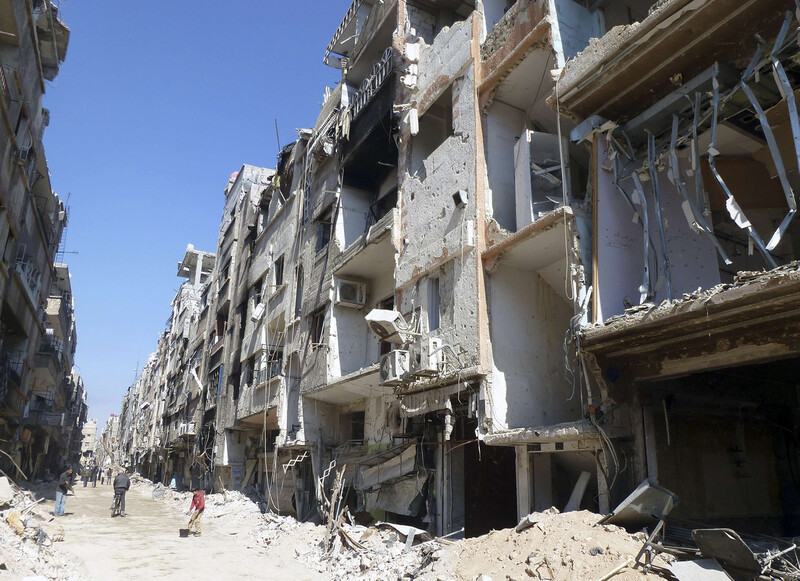
Civilians clean a street of the rubble of damaged buildings at the Palestinian refugee camp of Yarmouk, south of the Syrian capital of Damascus, 12 February.
Reuters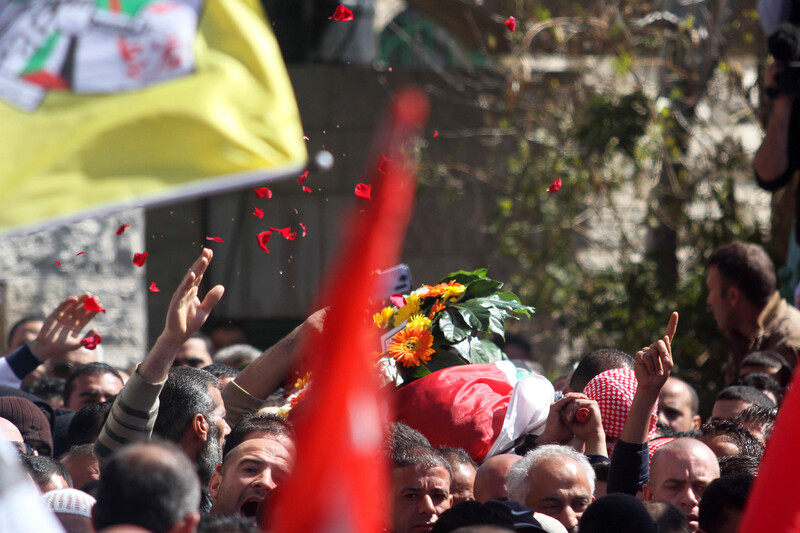
Palestinian mourners carry the body of Muataz Washaha, 22, a fighter from the Popular Front for the Liberation of Palestine during his funeral in Birzeit village north of the West Bank city of Ramallah, 28 February. The youth was killed by Israeli forces during a raid during which Washaha’s family home was destroyed.
APA images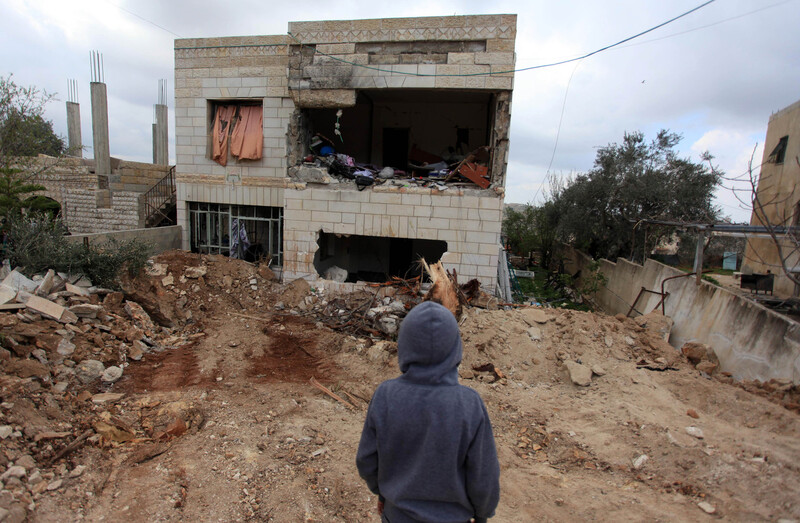
The destroyed home of Muataz Washaha, who was killed during an Israeli army raid in the West Bank village of Birzeit, 27 February.
APA images
Mohammad Saad stands with family members on 17 February holding the hat worn by Ibrahim Mansour and a stone taken from the place where Mansour was shot and killed by Israeli forces on 13 February while he was collecting gravel near the boundary with Israel. Saad was working with Mansour at the time, and says that no warning was given before a single shot struck the 35-year-old father of seven in the head.
ActiveStills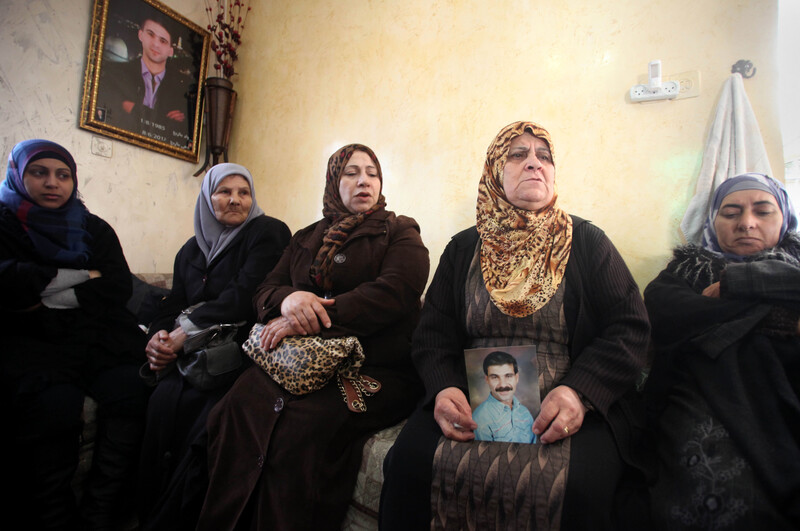
The mother of Palestinian prisoner Jihad al-Tawil holds her son’s photograph at her house in Jerusalem on 25 February. Jihad al-Tawil, 47, died in Soroka Medical Center in Beersheba, southern Israel on 25 February two weeks after he was assaulted by Israeli jailers during a raid in the prison. Relatives of al-Tawil told Ma’an News Agency that the father of five was serving a three-month sentence in Beersheba prison after he was arrested for driving a vehicle without a license.
APA images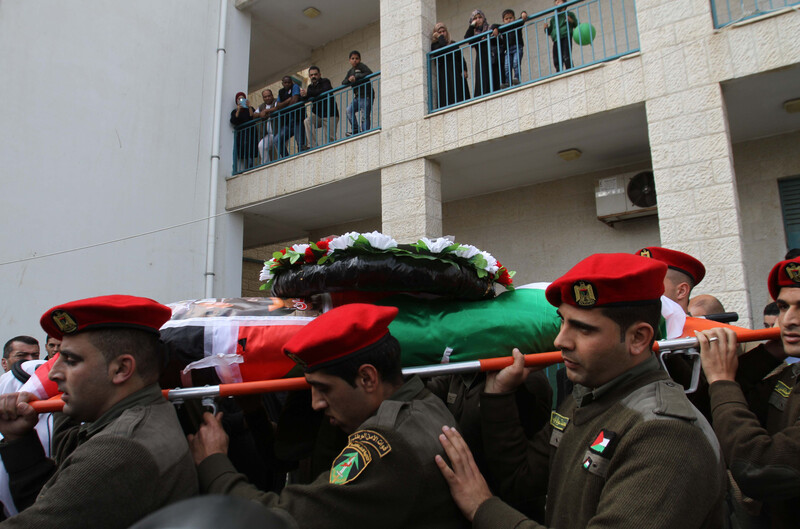
Palestinians carry a coffin said to contain the body of Palestinian fighter Sarhan al-Sarhan, who was killed 13 years ago, during his funeral in Tulkarem refugee camp in the occupied West Bank, 24 February. Israel pledged to transfer the bodies of slain fighters to their families.
APA images
Palestinians pray near the coffins containing the remains of Ayat al-Akhras and Daoud Abu Swai during their funeral in Dheisheh refugee camp in the West Bank town of Bethlehem, 3 February. Israel exhumed the remains of a number of Palestinian militants, including al-Akhras and Swai, to return them to their families for burial. Al-Akhras and Swai blew themselves up in two separate attacks during the second intifada in Jerusalem.
APA images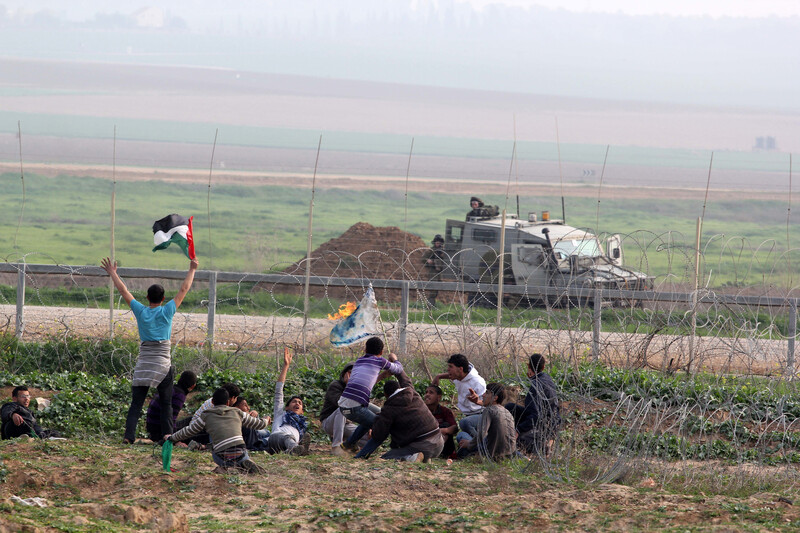
Palestinian protesters take cover during clashes with Israeli forces near the boundary with Israel east of Jabaliya refugee camp in the northern Gaza Strip, 14 February. The Israeli army fired live ammunition and tear gas at protesters, wounding 17, medics said.
APA images
Israeli soldiers arrest a Palestinian man outside his home during clashes in Jalazone refugee camp near the West Bank city of Ramallah, 14 February. Palestinians were protesting the killing of Mohammad Mubarak by the Israeli military in January.
APA images
Palestinian protesters clash with Israeli occupation forces following a demonstration against the expropriation of Palestinian land by Israel in the village of Kufr Qaddum near the occupied West Bank city of Nablus, 28 February.
APA images
Palestinian medics treat a boy wounded by Israeli occupation forces near the boundary with Israel east of Rafah in the southern Gaza Strip, 21 February.
APA images
Israeli border police jump out of their jeep after a tear gas grenade accidentally exploded inside it as they were trying to disperse the weekly protest against Israel’s wall in the occupied West Bank village of Bilin, 7 February.
ActiveStills
“Price tag” graffiti spray-painted on a wall of a Palestinian house in the Silwan neighborhood of East Jerusalem reads “Arab work is assimilation,” 10 February.
ActiveStills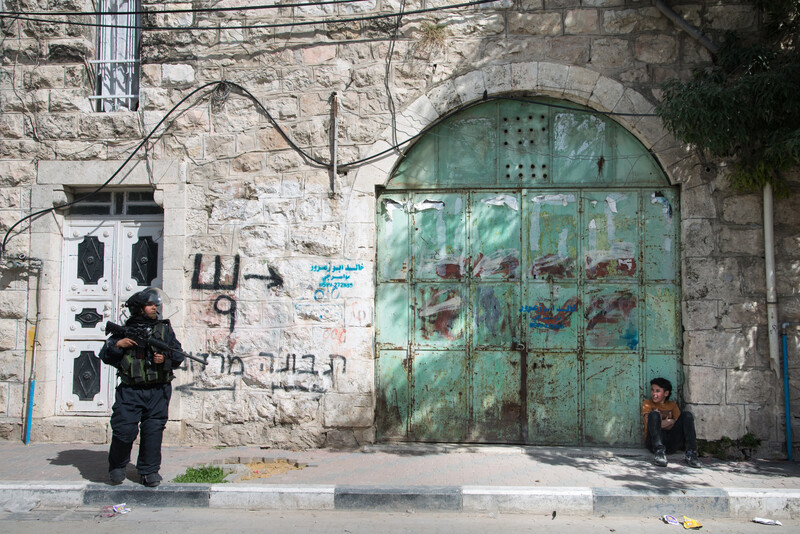
A Palestinian child sits on the sidewalk near an Israeli soldier during a demonstration to open Palestinian access to Shuhada Street in the West Bank city of Hebron, 21 February. Hundreds of protesters, including foreign and Israeli activists, gathered to mark the 20th anniversary of the closure of the street by the Israeli army following the Hebron mosque massacre perpetrated by Baruch Goldstein, a US-born Israeli settler, who went on a rampage inside al-Ibrahimi Mosque, killing 29 Palestinian worshipers.
ActiveStills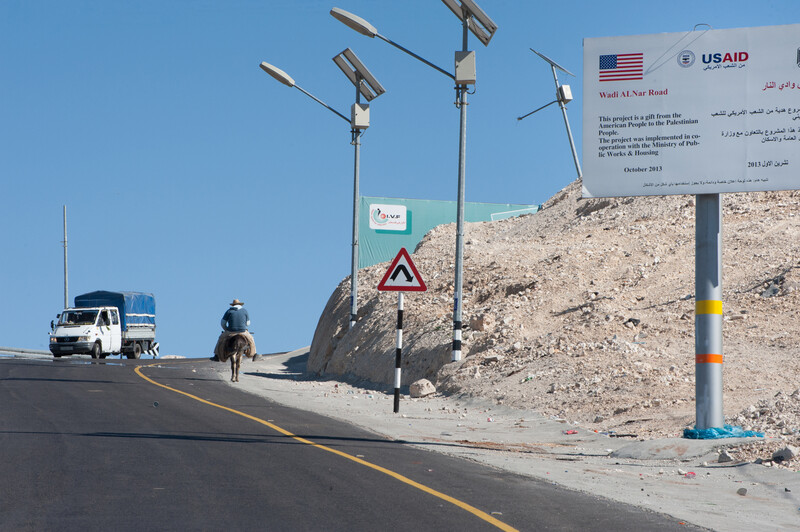
A Palestinian rides a donkey up a hill in Wadi Nar, the occupied West Bank, 13 February. The steep and winding road through Wadi Nar became the main thoroughfare for Palestinians traveling between the northern and southern West Bank after Israeli authorities closed access to Jerusalem, forcing Palestinians to take this treacherous detour. The road, which was recently rehabilitated with funding from the US government agency USAID, is the site of frequent, sometimes fatal, car accidents.
ActiveStills
Israeli authorities use tractors to destroy wheat crops planted by residents of the Bedouin village Lakiya in the Naqab (Negev) desert, 5 February. For years Israeli authorities have destroyed the village’s crops to prevent residents from making agricultural use of the land and thus claiming ownership.
ActiveStills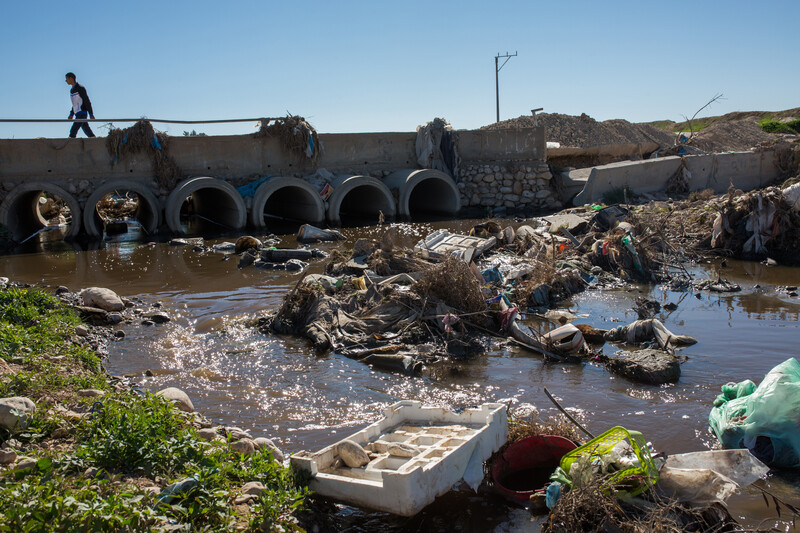
Sewage flows through the Bedouin village of Bir Hadaj in the Naqab (Negev) desert, 13 February. The Israeli government refuses to recognize the Bedouins’ historical rights over lands in the Naqab desert and denies residents of unrecognized villages basic infrastructure such as sewers, clean water and electricity.
ActiveStills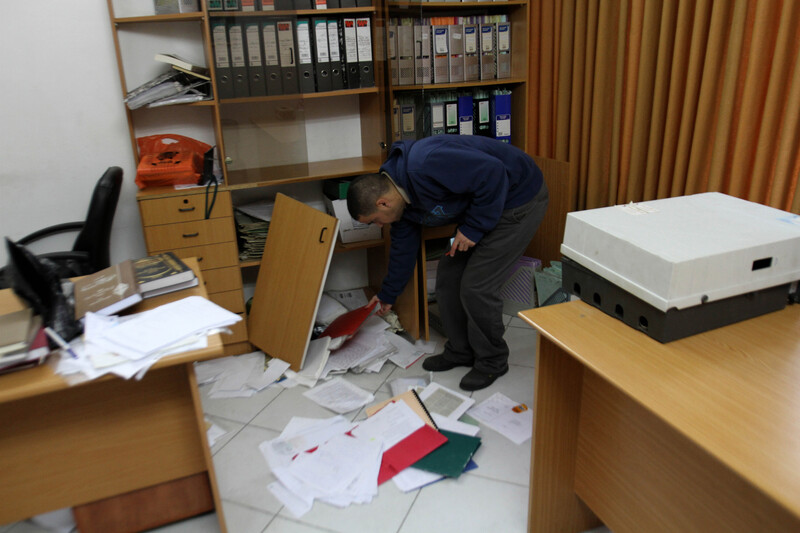
A Palestinian man inspects damage inside the Solidarity Foundation for Human Rights office in the West Bank city of Nablus after it was stormed by Israeli army, 25 February.
APA images
Sapir Sabah receives what was called “The Jewish State Award” in a ceremony organized by Michael Ben-Ari, the extreme right-wing Israeli politician and former member of Israel’s parliament, 9 February. Sabah is a high school student who publicly denounced her teacher, Adam Verete, for questioning the morality of the Israeli army’s actions in class. The award ceremony was attended by extremists Itamar Ben-Gvir and Baruch Marzel and their followers.
ActiveStills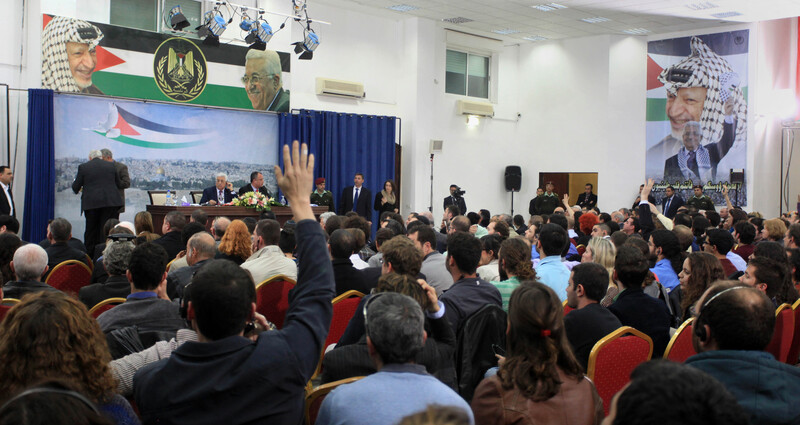
Palestinian Authority de facto leader Mahmoud Abbas meets with Israeli university students in the occupied West Bank city of Ramallah, 16 February. Some 250 student leaders and heads of student organizations from several Israeli academic institutions met with Abbas as part of a joint initiative of the Knesset Caucus to Resolve the Arab-Israeli Conflict, chaired by parliamentarian Hilik Bar and the National Union of Students in Israel.
APA images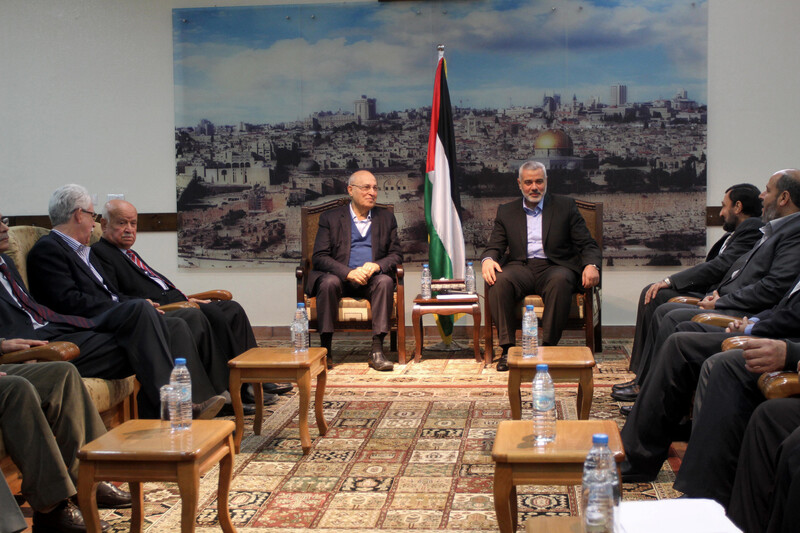
Ismail Haniyeh, de facto prime minister in the Gaza Strip, meets with Nabil Shaath, member of Fatah’s Central Committee, at Haniyeh’s home in Gaza City, 9 February. In a brief statement the Hamas government in the Gaza Strip announced that Haniyeh will meet with a Fatah Central Committee delegation to discuss reconciliation in an attempt to end to the Palestinian political division.
APA images
Activists in Amman, Jordan take part in a demonstration against US Secretary of State John Kerry and his peace proposal, 7 February. Kerry is pressing Israel and the Palestinians to agree on a framework to guide peace talks forward. The peace talks have in recent months focused specifically on security, with Kerry and his team proposing a detailed plan for the Jordan Valley, where the occupied West Bank borders Jordan.
APA images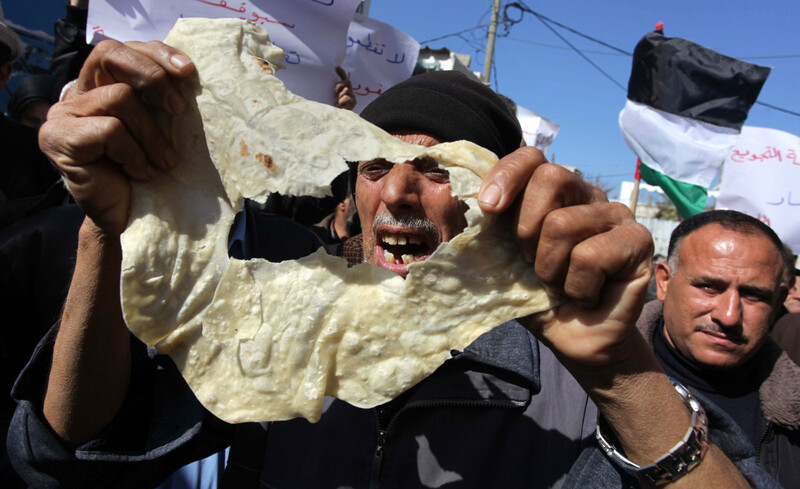
A Palestinian man holds a loaf of bread during a protest against UNRWA’s decision to reduce food aid, in front of the UN agency’s headquarters in Gaza City, 18 February.
APA images
Samer Issawi (center), who embarked on a prolonged hunger strike in Israeli prison before his release late last year, is greeted by activists in Jaffa’s clock square, 1 February. Jaffa activists staged daily protests in the months prior to Issawi’s release.
ActiveStills
Palestinian and international activists sit at the site of the old village known as Ein Hijleh in the Jordan Valley near the West Bank city of Jericho, 1 February. Activists launched the Salt of the Earth campaign to revive the village on land belonging to the Orthodox Church and St. Gerassimos monastery. The campaign was launched as a refusal of Israeli policies aimed at colonizing and annexing the Jordan Valley.
APA images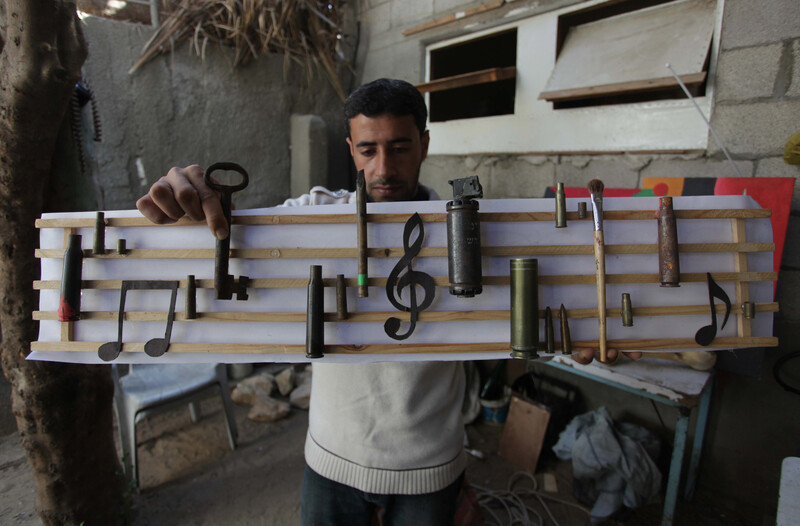
Mohammed al-Zomar displays one of his works made from spent Israeli ammunition at his studio in the central Gaza Strip, 12 February. Al-Zomar draws and paints on spent ammunition that he collected during Israel’s three-week assault on Gaza in winter 2008-09 and during the eight-day military offensive in November 2012.
APA images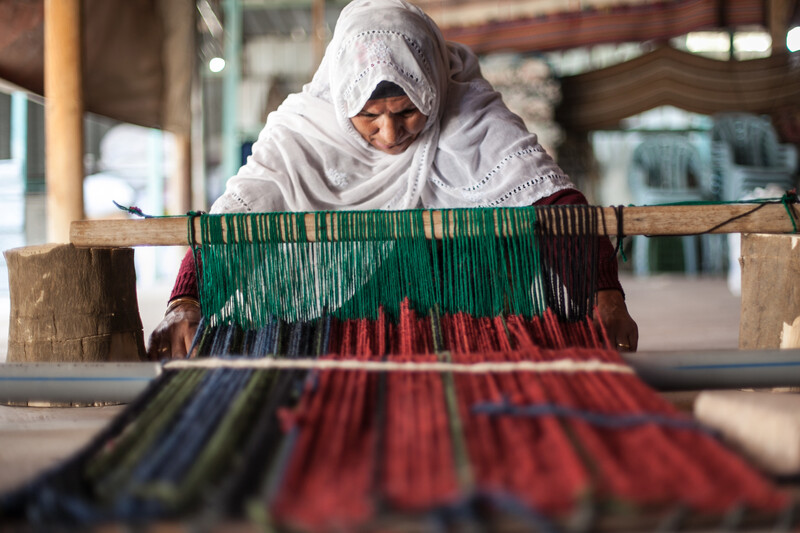
Hijar Elsaneh, a tour guide at the Lakiya Weaving Project in the Naqab (Negev) desert in the south of present-day Israel, threads a loom to make a traditional Bedouin wool rug, 22 February. The project empowers local women with education and a source of income through its production of locally-sourced, handmade woven products.

A Palestinian boy receives a vaccine at a hospital in Gaza City, 24 February.
APA images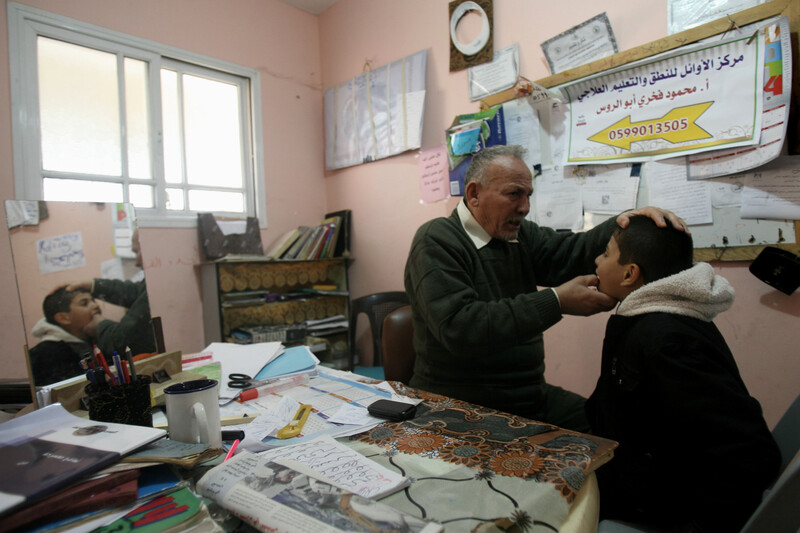
Mahmoud Abu Rous teaches a boy with a speech impediment during a lesson in Rafah, southern Gaza Strip, 19 February. Abu Rous assists children with the acquisition of all facets of language, from understanding the spoken word and reading fluently to articulating words clearly to help a child accelerate the acquisition of reading and writing skills.
APA images
Palestinian youths distribute flowers as part of a campaign honoring elderly women who sell goods in the streets in the occupied West Bank city of Ramallah, 22 February.
APA images
Hammad Atwa displays one of his handmade ouds at his workshop in the Khan Younis refugee camp in the southern Gaza Strip, 19 February.
APA images
A Palestinian girl sits amid lettuce crops at her family’s farm in Saffuriyya village near the city of Nazareth in the north of present-day Israel, 3 February. Saffuriyya was occupied by Israeli forces on 15 July 1948, when Israeli aircraft bombed the town. Most residents fled northwards toward Lebanon, with some elderly residents staying put. Only a few houses remain on the site.
APA images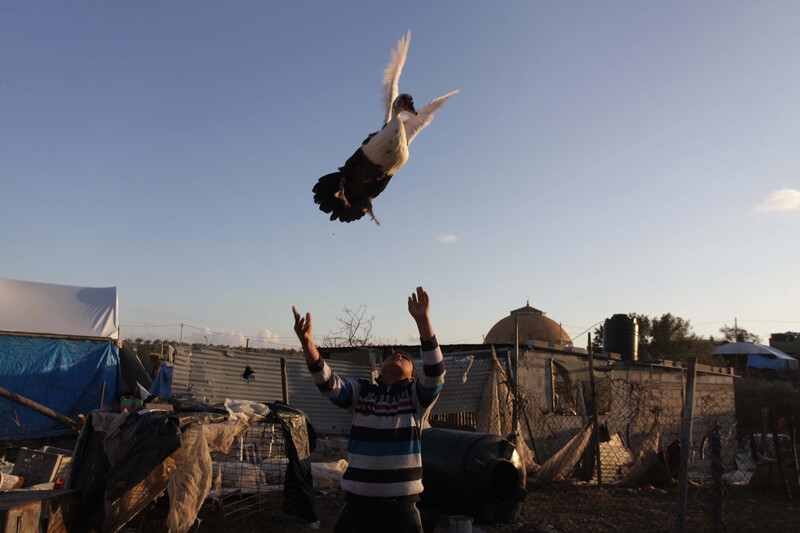
A Palestinian boy plays with a duck outside his family’s home in Khan Younis, southern Gaza Strip, 17 February.
APA images

